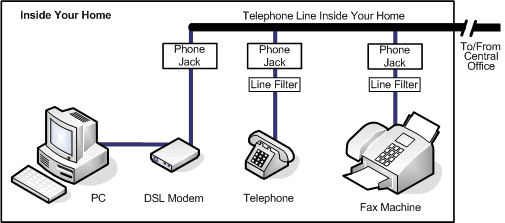- Online VoIP Comparisons since 2005
- 26.5+ Million page views: Testimonials
DSL stand for "Digital Subscriber Line" and is a technology for providing high speed Internet services to homes and small businesses over a standard tradtional phone line. It is known as an "always-on" service because unlike the old dial up service there is no logging on with user name and passwords required.
Setting up DSL service is easy. All you need to do is plug your PC into your modem (typically supplied by your service provider in most cases) and then from your modem to your normal telephone jack. This is illustrated in the diagram below.

Assymetric DSL (ADSL) service is the most common type used by homes and businesses. Assymetric means unequal and typically the transfer of information (data) from the Internet to your PC (download) is much faster than the transfer of information (data) from your PC to the Internet (upload). The assumption here is that most people acces information (download) rather than sending (uploading) information. Other variations are as follows:
Available speeds from this type of service are continually improving. It use to be that the only option was a 1.0Mbps downlink and a 128kbps uplink plan. As technology has improved enhanced plans are being offered claiming speeds up to 15Mbps (and more depending on your location) on the downlink and 384kbps on the uplink. Of course, you pay a premium for the enhanced service options but this technology still remains one of the cheaper options for Internet access in your home and small business. It may not always be the cheapest option as typically service providers require you to also subscribe to their phone service, which can be costly compared with an option like VoIP.
Your speed will depend on the distance that you are from the telephone company Central Office (CO). Typically, the closer you are the faster your Internet speed will be. There is a maximum working distance of 18,000 feet, as illustrated in the diagram below.

So, for you to get service you will need to make sure you are within this limit from your local telephone (provider) company central office. This is easy to do. You just go to the service provider website that you are interested in, enter your telephone number details and the search will check to see if it is available to you.
As mentioned previously, this technology provides one of the cheapest options for getting Internet service to your home and small business. Many providers start their standard plans in the $20 per month range and this typically gets you the 1Mbps range download speed. Expect to pay in the $35 to $40 per month range for enhanced plans with increased speeds.
Here are some advantages to consider:
Here are some disadvantages to consider:
Overall, DSL Internet service is an excellent choice for high speed broadband access. Check out our DSL vs Cable guide for a comparison summary between the two main broadband technologies available.
What is Broadband Internet Service? |
NEXT What is Cable Internet Service? |